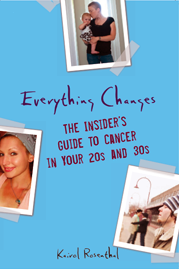
Ina, Martha, and Nausea
This week on the Stupid Cancer Show, I interviewed Karen Jung author of Healthier Eating and Living with Cancer. I’m a big fan of Ina and Martha and the aesthetic of their presentation. Karen agrees that visual appeal can make it or break it with cancer in the nausea department. She suggests experimenting with the colors of plates against the color of various foods, recommending white plates for brightly colored vegetables. She also recommended taming the olfactory-gag effect of food by cooking with the kitchen door closed (if you have one) and allowing food to cool before serving.
Vegan Cancer Girl Scouts
Vegan is the new black. Everybody is doing it. Suddenly the oh-so-seventies rage of juicing and raw foods is hot among young adult cancer survivors and pedestrians alike. But Karen’s recipes aren’t about beet juice margaritas for dinner. I was curious why she chose standards instead: During active treatment, patients often cannot digest abrasive raw veggies or potent green shakes. Karen tested her recipes on scores of survivors in radiation treatment and chemotherapy, and there is a reason why they serve Jell-O in hospitals – sometimes it is all you can get down.
On The Page
She had lots of great ideas when I talked to her but when I read her book they were not mentioned. The cover is beautifully designed, but some of the suggested foods like hot dogs on hoagie buns didn’t shout cancer, nor would I need a cookbook to make scrambled eggs. I’m not a nutritionist but the antioxidants she notes that come from two slices of cheese in a grilled ham and cheese sandwich seem like a snippet of nutritional information lifted out of context. The order of the book is also confusing; cookies listed after appetizers and before meats, while vegetables are the final section. My conclusion, if I’m hankering for Hungarian goulash, I’ll reach for the Joy of Cooking instead.
What were your favorite cancer foods? How did you hack the sight of food when you wanted to hurl?
![]()
![]()
 “Everything Changes is, without doubt, the most forthright, emotionally sophisticated, and plain-old valuable book of its kind I've seen.”
“Everything Changes is, without doubt, the most forthright, emotionally sophisticated, and plain-old valuable book of its kind I've seen.”













February 6th, 2009 at 9:15 PM
as much as i am a huge fan of your writing, i also love the pictures that you choose for each post. good stuff. keep it coming!
February 9th, 2009 at 7:34 PM
When my 29 year old son Silas first started chemo, he couldn’t keep anything down. The thought of ensure or milkshakes gagged him, so he mostly lived on fruit juice and ice blended, and then moved it up to recharge or gatorade, and popsicles. Fortunately, smoking a bit of pot helped enough for him to try noodle soup or cereal. Eventually Silas found ways to keep the nausea under control, and regained his appetite, (steroids after chemo helped); I was so grateful that he never experienced that bad chemo taste. Foods ranged from Captain Crunch & Fruity Pebbles cereal, to pancakes, sausage & hashed browns or waffles. Some days it was really “healthy” food from the chinese or thai restaurants, home cooked soups and stews from my sisters, and other days it was corn dogs, pizza, or canned soup. Silas loved to eat all kinds of foods, even though he was raised on a basically sugar free and whole foods diet. During radiation it became difficult for him to get any food down again, and he would sometimes eat Stonyfield yogurt with the cream on top, and pasta in creamy sauces. Often the challenge would be to get the food that sounded good prepared before it didn’t sound appealing anymore. And to have a few foods on hand like popsicles and noodle soup or whatever else doesn’t seem to trigger the nausea button most of the time. I think that one of the many stressful things about cancer is that we hear so much about diet & what is a “good” food or a “bad” food, and during treatments it can be difficult to get any nutrients in your system, let alone censor what goes in. Then there is the whole controversy over anti-oxidants interfering with treatments, etc. All very confusing. I felt that during treatment the most important thing was to keep weight on, so that you can have the strength you need to keep going. What do others think about this? Thank you.